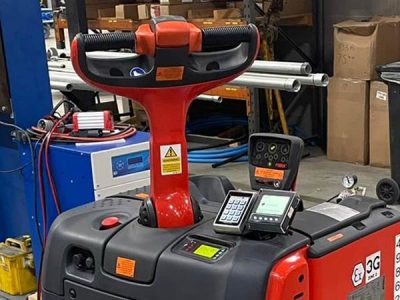Paint spray booths are a common sight at many manufacturing plants, but did you know that they are typically hazardous areas? Matt Booth explains the risks of transporting materials into a solvent-based paint spray booth.
The first question is, how is your paint spray booth classified?
When a paint spray booth is under operating conditions using flammable, solvent based paint, a potentially explosive atmosphere is clearly created. In other words, don’t walk in with something that may cause an ignition!
Of course, every operation is different, and a thorough risk assessment (ATEX / DSEAR) should be conducted which considers each stage of the process and factors such as ventilation.
Recently, what we are finding is that many operations are undergoing new or refreshing their risk assessments which result in the need for ATEX complaint equipment, including protection for the materials handling equipment taking materials in and out of the area before and after the spraying activity. Whether it’s car parts, wind turbine blades, small metal components or even household goods and toys, there may be a risk of explosion.
This means the equipment that lifts pallets, tows trailers or trolleys full of component parts, or other items, into the spray booth (hazardous area), should be protected. Often the risk assessment concludes the equipment should be ATEX 3G compliant (known as explosion protection), which is suitable for the Zone 2 classified hazardous areas.
Pictured below is an example of a tow truck that will be towing trailers into a paint spray shop where pumps and motors are spray painted. This company requested ATEX compliant equipment to help manage the risk of explosion when transporting goods. In other words, it can’t now be a source of ignition (from hot surfaces or switches, static etc.)
This ATEX compliant tow truck (ATEX 3G, T4) will detect the presence of a flammable atmosphere, alert the operator and shut the truck down if necessary. It features Pyroban’s system6000 (see below for more details).
The problem with solvent paint spray booths
The trouble with Solvent based paint spray booths is that people become accustomed to the smell of the rich odour of solvents, even when there is sufficient ventilation and don’t always appreciate the potential risks.
In most cases the strong solvent smell is far from being potentially explosive (call me if you want to know the science and all about the stoichiometric mix!), but it could be, and using standard machinery such as forklifts or tow tractors could cause an explosion.
Pyroban ATEX gas detection in paint spray booth
When we put an ATEX truck into a spray booth application that previously used standard equipment, we find that after even a week in use, it will have already detected high concentrations of gases and vapours in the spray booth. Sometimes it will cause an alarm, and sometimes a full shut down which happens automatically to avoid any human error.
A close call!
I can only imagine how close some of the operators may have previously come to being involved in an explosion as a result of using the standard equipment. This is something that no employer should ever knowingly allow and I personally avoid those areas if I see these activities on my site visits (while making managers very aware of the risks)!
How system6000 gas detection works
For ATEX compliant pallet trucks, stacker trucks, tow trucks or any type of handling equipment, Pyroban’s system6000 combines gas detection with various explosion protection methods such as restricted breathing enclosures, stainless steel cladding of forks and surface temperature monitoring to ensure the motors, electrics and other components remain below the auto-ignition temperatures of flammable materials.
System6000 can also support fleet management solutions with keypad access control for example, as seen here (with the system6000 control module in the background behind the keypad)
On detection of flammable hydrocarbons the ATEX trucks will be brought to a controlled stop and electrical systems turned off. The gas detection system consists of a gas sensing head (gas detector) that, once initiated, is constantly monitoring the atmosphere (as the equipment moves within the facility) for the presence of flammable vapours and gases. In this case the flammable vapour from solvent-based paint.
If a low concentration is detected an audible and visual alarm will be triggered but the truck retains full functionality. This will allow the operator to take appropriate action and drive out of the area and wait for the ventilation to clear the area.
To ensure that the operator is instantly informed when vapour is detected, the control module for the system is located within easy reach and view of the operator. The system also helpfully includes an auto-calibration function which removes the need for periodic and costly site visits by service engineers to recalibrate the gas detectors. It also removes the risk that the gas detection system could be operating out of calibration for significant periods of time.
Protecting your people and business
When the vapours approach a more dangerous level, the trucks will automatically shut down and protect the operator and all other staff from the risk of an explosion.
Read more about system6000 for ATEX Zone 2.
Matt Booth is Pyroban’s UK Sales Manager. Connect on LinkedIn.




